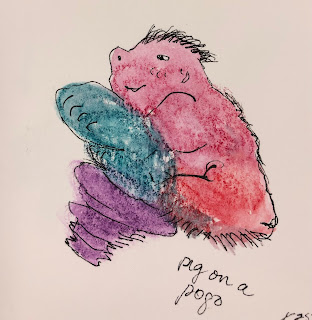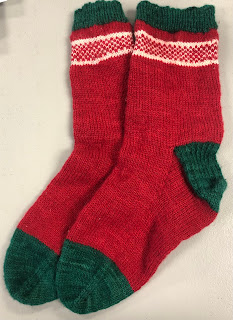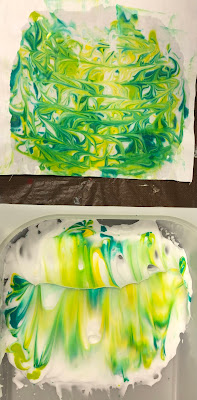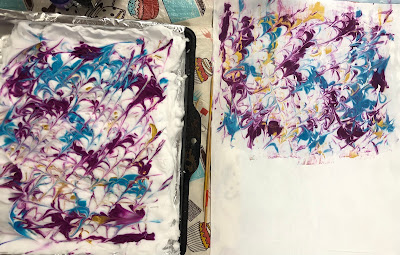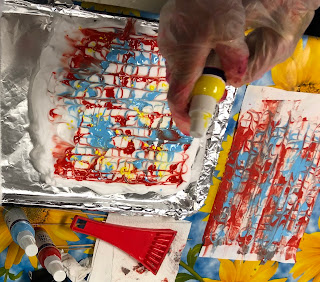In this blog post I will give a short summary of the women chosen by our members for their challenge this year. As the year progresses I will add to it as they are presented. If you have missed a meeting and would like to see who has chosen whom you can check back here.
Trailblazing Women of BC and Yukon
Jan
Kristin Miller
Jan was inspired by a more modern woman, Kristin Miller. She was one of many young women from all over North America who left their homes and travelled west and north. Many ended up on the north coast of BC in the 1970's and 1980's. Many had no experience living on the ocean or in isolated locations. They managed to find cabins or build them out of salvaged and affordable materials. There was no electricity or running water. A requirement of independence was learning to operate a boat.
Kristin lived across the bay from Prince Rupert in the Salt Lakes area. Kristin arrived in 1978 with a partner but found herself alone when her relationship broke down. She chose to stay and be on her own to heal. She packed up her electric sewing machine and bought a treadle machine. When she realized she could not have children she took it upon herself to shift her attitude and embrace other people's children.
She did this by sewing baby quilts and teaching others to do the same. A strong support group was formed with women and a few men coming from surrounding area's to have quilting parties. Eventually the group started sewing quilts for other occasions as well. Quilts were a means of showing love and support. Eventually Kristin suggested presenting their works of art to the Museum of Northern BC in Prince Rupert. During the years Kristin lived on the North Coast she wrote and published a book called the Careless Quilter. She also engaged a group of women who built quilts in the round robin style. She now lives in Powell River, BC.
Book - Careless Quilter, Decide-as-You-Sew, Design-as-You-Go, Quiltmaking
Book - Knots and Stitches, Community Quilts Across the Harbour, Caitlin Press
Book - Gumboot Girls, Adventure, Love and Survival on the North Coast of BC, contibuted a chapter.
Website - https://knotsandstitches.ca/ Knots and Stitches-North Coast Live and Quilts
Shirley
Helen Gregory MacGill 1864-1947
Helen was the first woman to graduate from Trinity College as well as the first woman judge in British Columbia, where she served on the juvenile court for 23 years. Her mother was a suffragist who taught her daughter that a woman's role as a mother afforded her a right and responsibility to seek gender equality in order to contribute to society's improvement. Her daughter, Elsie MacGill became the world's first female aeronautical Northeer and aircraft designer.
She was the first woman the British Empire to earn a degree in music. She travelled across Canada and to Japan as a journalist. Helen purchased and wrote for two newspaper and advocated for greater rights for women at a time when women could not inherit money, hold public office, serve on juries or vote.
She married Lee Fleshcer and had two sons with him before he died in 1901. In 1902 she married Jim MacGill and moved to Vancouver. Two daughters were added to the family. She continued to write and joined or formed several organizations that advocated for legal reform and greater concern for women, children and the poor. She was at the forefront of the fight in BC which granted women the right to vote in 1917. In July 1917 at the age of 53 she became BC's first female judge when she was appointed judge of the Juvenile Court of Vancouver. She served as a juvenile court judge from 1917 to 1929 and again from 1934 to 1945. Helen retired in 1945 at the age of 81. She was the first woman to receive a honorary Doctor of Laws from the University of British Columbia.
Elsie, her daughter, wrote that she was constantly moved by her mother's "passionate, yet objective sympathy for the hurt, the helpless and the exploited."
Elisabeth
Hannah Maynard 1834-1918
Hannah was a photographer best known for her portrait work and experimental photography involving photomontage and multiple exposures. Many of her photographs are self portraits or include her family as subjects. She also photographed people using techniques that made them appear as statuary: on columns or posing as if they were made of stone.
Hannah and her husband, Richard, emigrated from Cornwall to Ontario in 1852 and Richard soon headed west to join the hunt for gold. While he was out west Hannah learned the basics of photography. The family moved west in 1862 and Richard again headed out looking for gold while Hannah stayed and opened her first photographic studio, Mrs. R. Maynard's Photographic Gallery.
In the ensuing years Richard also took up photography though they had very different specialties, Hannah was best known for her portrait work and Richard focused on outdoor photography. Starting in about 1880 Hannah began to experiment photomontage in her Gems of British Columbia series. Between 1897 and 1902 she was the official photographer of the Victoria Police Department, producing mug shots as well as portraits of the officers. When she retired in 1912 she summarized her achievements by saying "I think I can say with confidence that we photographed everyone in the town at one time or another."
Christine
Phyllis Munday 1894-1990
Phyllis was a mountaineer and belonged to the Girl Guide movement all her life.
Phyllis Beatrice James was born in Ceylon and moved to Kootenay Lake and in 1907 moved to Vancouver. The Kootenays gave her a love of the outdoors and she spent time on Grouse Mountain. In 1915 she joined the BC Mountaineering Club and in 1916 she established the Girl Guide movement in BC. She met her husband Don Munday, who returned from the war injured, at the hospital in New Westminster and they married in 1920. They had their only child Edith in 1921.
In 1923 local promoters purchased much of Grouse Mtn. and persuaded Don and Phyllis to develop Grouse for recreational use. While living in a tent on Grouse, Don build a cabin that in 1924 served meals and refreshments. Throughout the 1920's and1930's Don and Phyllis climbed many of the coastal mountains and the mountains on Vancouver Island, giving them names. The most well known is Mt. Waddington. In 1924 Phyllis became the first woman to climb Mt. Robson. Whilst living on Grouse made Guiding accessibility difficult, Phyllis had the idea that girls in remote communities would like to join the Guide movement and she formed the Lone Guides and linked girls living remote communities from Alaska to California by newsletter.
In 1950 Don died from complications of being gassed in WW1, Phyllis was devastated but was determined to carry on and she held numerous positions with both BCMC and the Guides. Phyllis was a member of the Canadian Alpine club and an honorary member of other mountaineering clubs around the world. In 1972 she was inducted into the Order of Canada and in 1998 a Canadian mail stamp was printed in her honour.
Cathy
Kate Carmack 1862-1920
Kate was born in 1862 as part of the Wolf of the Dakl'aweidi tribe in the Killer Whale Nation located in what is now known as Telegraph Creek, Yukon. Her first husband and infant child died of influenza and she later married her deceased sister's husband, George Carmack. Kate earned a living by taking in laundry, sewing moccasins and winter clothing to sell to miners. She was an excellent forager and trapper.
After having a dream where she pointed her walking stick in the direction of the Klondike and everything turned to gold, she and her family headed on foot to the Klondike. Without Kate's knowledge of the area and her trapping skills they would not have made it.
On August 17, 1896, Kate discovered a large nugget of gold in the Eldorado Creek and the excavations began. Afterwards the group left Dawson on a sternwheeler with somewhere near $250,000 in gold. They leased their claims and increased their wealth. Kate wore a flattened gold nugget necklace, stickpin, gold bangles, rings and a belt with a gold buckle daily. After her marriage fell apart Kate returned to Yukon and her brother build her a cabin in Carcross. She never saw her share of the mining riches and lived off a government pension until she died at age 63. Her brother left a trust fund for the creation of the Skookum Jim Friendship Centre in Whitehorse. The centre still exists today.
Cath
M. Wylie Blanchet (Capi) 1891-1961
Born in Lachine, Quebec she was a tomboy and avid seeker of the natural world. She considered studying archaeology at university but married Geoffrey Blanchet and they had 4 children before his poor health left him unable to work. With a settlement from his employer they bought a car and traveled west. Settling on Vancouver Island in an older house near what is now the Swartz Bay ferry terminal. Geoffrey died under mysteries circumstances, his clothes and wallet were found on board their boat and the swim ladder was down so it was assumed he had a heart attack while swimming.
Capi was now the sole support for her family of 5 children and she supported them by writing freelance articles for a variety of magazines and renting out their home, called Little House, to a family from Washington State every summer for 15 years. She packed up the children and sometimes the dog on their boat, Caprice, a 25 foot long gas boat and they spend the whole summer travelling up the BC coast and exploring secluded coves and meeting the inhabitants.
Capi kept a journal of their trips and considered the travel a continuation of the education of the children. She kept the boat and motor in good repair and navigated dangerous tides and currents in unpredictable waters. When the children were grown up she was encouraged to put her journal stories into book form and so wrote her book, The Curve of Time, as if it happened all one trip while in reality it happened over many summers. The title of the book comes from some writings she had on board the Caprice, by Maurice Maeterlinck, a Nobel Prize winning playwright and poet, who considered time as a curve where if you are standing at the top of the curve in the present you can simultaneously view the past and the future.
The Curve of Time by M. Wylie Blanchet
Lena
Susan (Moir) Allison 1845-1937
Born in Sri Lanka, the youngest of 3 children, her family were tea plantation owners until her father died when she was 4. The family moved back to England and Susan attended school in London where she learned Greek, Latin and French and would later add Chinook Jargon to her languages. At 15 the family moved to Hope, BC with her step-father. Later she and her mother opened a school in Hope. It was a busy centre at the time with trading, mining and road building going on.
At 23 she married John Fall Allison and set out that evening with a pack train to the Similkamean. It was the first time a woman rode through the rough trail that later became Allison Pass. They made their home near present day Princeton by the river and lived there and also in Sunnyside, which is present day West Kelowna, with the 14 children they had together. The small log cabin they build there still stands at Quail's Gate Winery.
Through many of her stories she would document her life as a pioneer settler in the Similamean and Okanagan valleys. She wrote a series of articles about her early life in Princeton and about the Indian legends that were told to her directly from her Native friends. These writings caught the attention of the editor of the Vancouver Daily Province in the late 1920's and he was eager to preserve these memories of the pioneer settlers. After her 80th birthday, at the urging of this editor, she began to write about her recollections. They appeared in the paper in 13 issues. They are also presented in a book:
A Pioneer Gentlewoman in British Columbia - The Recollection of Susan Allison, edited by Margaret A. Ormsby.
Brigitte
Mary John Sr. 1913-2004
Mary was born at Lheidli, near Prince George, in Saik'uz(Stoney Creek Village). She was a member of the Tack clan, whose crests are caribou and ruffled grouse. She survived the 1918 flu epidemic and at only 5 years old took care of her ailing mother. At 8 she was sent to residential school in Fort St. James and then moved to another residential school which she attended until she was 14. At 16 she married Lazare John and they had 12 children together.
In 1942 she helped found the local chapter of BC Homemakers Association, the association was intended by the Department of Indian affairs to teach homemaking skills to native women. Mary and other women turned in to a vehicle for political action. In the 1950's she founded the Welfare Committee which worked to place aboriginal children in aboriginal foster homes in or near their own community. In 1980 she established the Stoney Creek Elder's Society, they built a Potlatch House and campground, and provided the impetus for social change and political action.
She was very concerned with the preservation of her culture and language and was one of the founders of the Yinka Dene Language Institute. From 1992 till her death she worked tirelessly to document her dying language. Mary received many honours later in life, including a Membership in the Order of Canada and the Queen's Jubilee Medal. In 2008 the Vanderhoof Public Library opened the Mary John Collection, a collection of 800 books on First Nations topics created in her honour.
Judith
Sophie Morigeau 1836-1916
A remarkable and unusual woman, she lived life on her own terms. Born of a Metis mother and fur trader father she married at 16 but walked away from her husband and ran a pack train business in BC, Montana and Washington. She was apparently run out of Golden for bootlegging. Later in life, having been robbed by her current partners, Sophie quit the pack train and bought a ranch in south east BC, becoming one of the few women landowners of her time.
After an accident where she lost and eye she took to wearing a patch and later on bright green glasses. When she broke a rib which protruded out of her body, legend is that she amputated it herself and hung it in her cabin with a pink bow. It is also said that some of Sophie's men friends disappeared under strange circumstances when they didn't leave as requested.
In general, Sophie is described as friendly, assertive capable and independent. A feminist way ahead of her time.
Jeanette
Daphne Odjig 1919-2016
Daphne was born on the Wiikwemikong Reserve on Manitoulin Island in Ontario to a descendent of a Potawatomi chief and an English mother. She contracted rheumatic fever at 13 and had to leave school. Her paternal grandfather, a stone carver, sketcher and painter, gave her artistic instruction while she was at home. She moved to Toronto following the death's of her mother and grandfather and worked in factories and in her spare time explored art galleries. She taught herself to paint by observing and copying works of the masters.
In 1964 she attended the annual Wiikwemikong Pow Wow and was deeply inspired by the proud cultural display. At this time she chose to redirect her artistic work from a traditional realistic style to a style that celebrated the traditions of her people. Her break through into the art world happened when she received critical acclaim for pen and in drawings about the Chemawawin Cree being displaced from their land to make way for a dam.
In 1971 she helped establish the first Indigenous owned and run art gallery called the New Warehouse Gallery, the first Canadian gallery exclusively representing First Nations art. Her 8x27 foot canvas, The Indian in Transition, is considered by many to be her masterwork.
Sandie
Isabella Mainville Ross 1808-1885
Isabella, a Metis woman, was the first female registered landowner in BC. In 1822 she married Charles Ross, a boatman for the Hudson's Bay Company. They moved around BC to a variety of trading forts for the company. In 1843 they moved to Fort Victoria as Charles was promoted to Chief Trader for the HBC. He died suddenly leaving Isabella with nine children.
With money left to her in Charles will Isabella purchased 99 acres of land in Victoria. This made her the first female landowner and likely the first Indigenous person to own land in BC. Isabella named her property Fowl Bay Farm after the area's waterfowl. Her children attended school while she worked the land and sold livestock and farm produce. Though she couldn't read or write she spoke French, Ojibway and English.
A tall handsome stone at Ross Bay Cemetery bears Isabella's name on the very land where she raised her family and ran her farm.








































